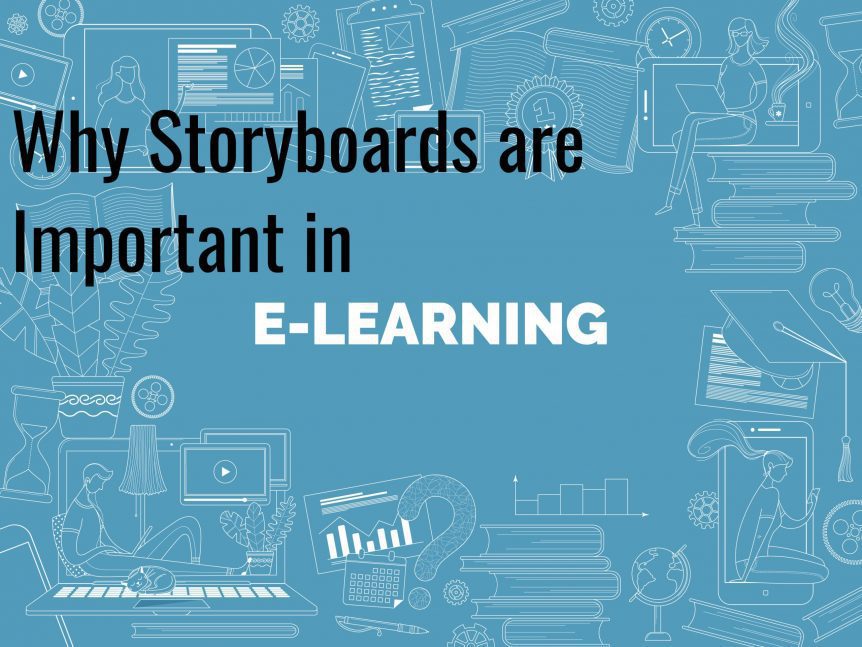Why Storyboards are Important in E-Learning
When creating an e-learning course, it is important to have a proper plan to ensure the design process is efficient and delivers on your objectives. Storyboards are a central component of that plan.
Storyboards in e-learning are similar to storyboards in other creative projects (such as creating a video) as they outline the various screens that learners will be presented with as they proceed through the course. Storyboarding is one of the first steps of the design process, taking place before any of the technical design work begins.
Why do we use storyboards when we create e-learning courses for clients in the UAE and Saudi Arabia? There are several reasons, including that storyboards enhance quality and improve the design process.
How Storyboards Enhance the Quality of E-Learning Courses
Storyboards improve e-learning quality in three main ways:
- Improves storytelling, course structure, and content organisation – it can be very difficult to visualise the entirety of an e-learning course without a storyboard. They are a visual way of looking at the structure of the course and how you’ve organised content. This can help you identify problems, including missing sections. You can also get a better understanding of the storytelling that learners will experience and whether that storytelling will be effective.
- Ensures learning comes first, not design – design is important in e-learning, but it doesn’t come before learning. By creating a storyboard, you maintain focus on how you are presenting the content of the course to learners, with minimal consideration of design. The design element will come later.
- Improves the learning experience – the above two benefits combined result in an improved overall learning experience. This improved learning experience delivers better outcomes, helps you achieve your learning objectives, and ensures you get a return on investment.
How Storyboards Improve the Design Process
Storyboards are also important in e-learning as they make the design process better. The advantages of storyboards when developing e-learning courses include:
Makes E-Learning Development More Efficient
Storyboards take time at the start of the design process, but they will save you in the long run. They save time because they help put in place an agreed structure for the course before the time-consuming technical element begins.
The alternative is to get straight into the technical design. Using this approach, issues with the design, structure, or organisation of the course may not be identified until well into the process. Undoing or redoing work at this stage is much more expensive and will take a lot more time than making changes earlier, ideally before the design work begins, i.e., while storyboarding.
Saves Money
As e-learning development is more efficient when storyboarding is part of the process, you will also save money. The technical design part of the project takes the longest, so minimising changes during this part of the work is a priority.
Enhances Collaboration
Storyboards are easy to share with the various stakeholders that are part of the design process. They are also easy to understand and discuss, plus changes to storyboards are quick and easy to make.
In other words, they are a highly effective feedback tool, so they contribute significantly to the level and quality of collaboration that takes place, particularly in those crucially important early stages of the project.
Improves Understanding Between Designer and Client/Owner
When developing an e-learning course, it is important the designer and the client/owner of the course are in harmony. So, the designer needs to have a thorough understanding of what the client/owner wants to achieve, and the client/owner needs to be clear about the direction the designer is taking.
There is no better way to do this in the early stages of developing an e-learning course than with storyboarding.
Again, the alternative of not using storyboards can be very costly in terms of both time and money, as it is difficult for the client/owner to fully understand where the designer is going with the project until they see the actual technical designs. If they are not happy, the changes that will have to be made are costly and time-consuming.
Having these discussions at the storyboarding stage is much simpler, quicker, and more effective.
Keeps the Design Process Focused on Learning Objectives
As with any design project, whether you are creating a website, animated video, or e-learning course, it can be easy to get caught up in the design, focusing on visuals and features.
However, to create an effective e-learning course that delivers a return on investment and ensures a great learning experience, it is important to remain focused on the learning objectives. Storyboarding helps you achieve this goal.
Improves the Quality and Accuracy of E-Learning Courses
Finally, storyboarding helps improve the accuracy and quality of e-learning courses as you can more easily identify problems and errors early in the process when they are quick and easy to resolve.
For example, you might have a good idea about how the course content should be structured, but it is hard to fully visualise that structure until you see a storyboard. You can then confirm your structure will work, or you can identify weaknesses and areas for improvement.
Storyboards: A Simple but Effective Tool in E-Learning Design
Storyboards are not technically difficult to produce, they are light on detail, and they are typically produced in a rough format. However, their importance to the e-learning development process shouldn’t be underestimated. In fact, the more time and effort you put into storyboarding, the more efficient and effective the overall process will be.

